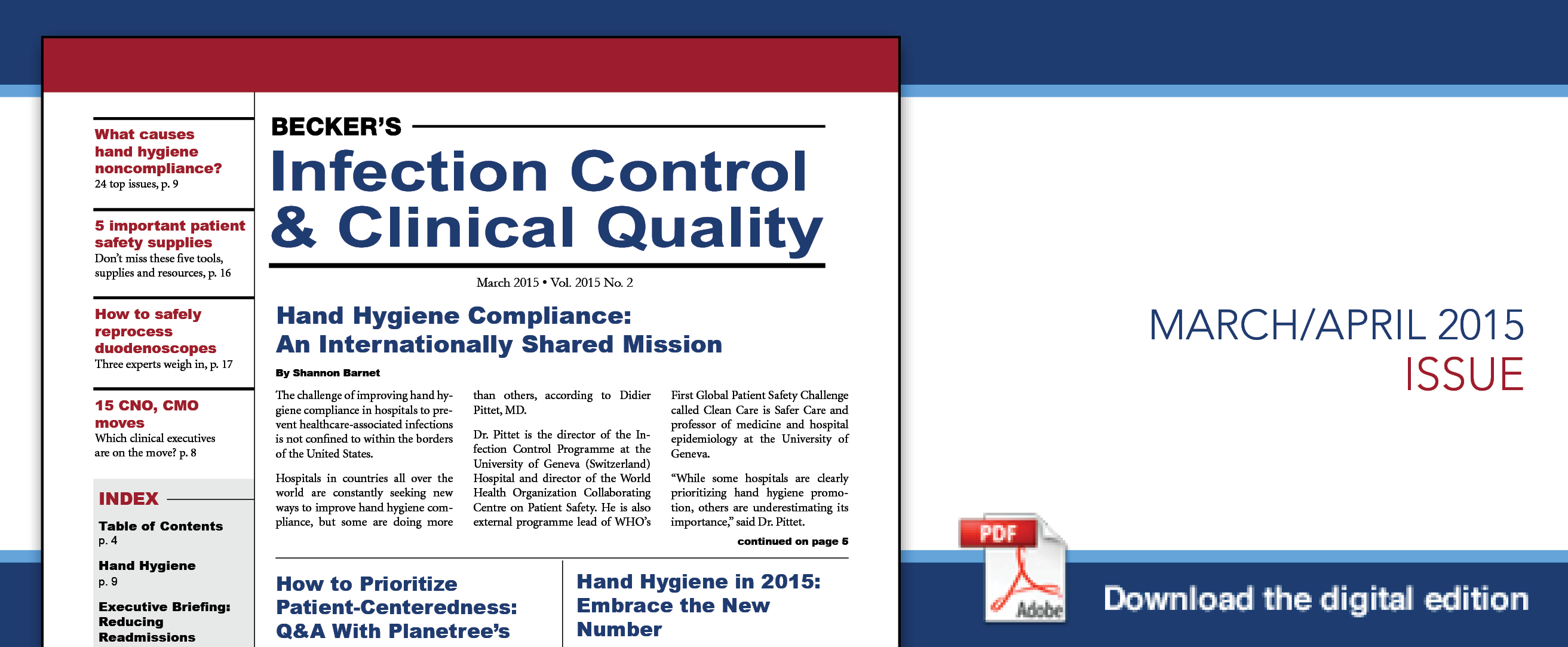March/April 2015 Issue of Becker's Infection Control and Clinical Quality
On the Cover
|
|
Hand Hygiene Compliance: An Internationally Shared Mission |
|
|
How to Prioritize Patient-Centeredness: Q&A With Planetree’s Dr. Susan Frampton |
 |
Hand Hygiene in 2015: Embrace the New Number |
Hospital & Health System CMO, CNO & Chief Quality Officer Moves
Hand Hygiene
What Causes Hand Hygiene Noncompliance? 24 Issues
Hand hygiene compliance rates remain generally low despite the well-documented connection between improper hand hygiene and healthcare-associated infections — but there are many varied reasons healthcare workers don't comply to hand hygiene protocol, a study published in The Joint Commission Journal on Quality and Patient Safety found. Click here to continue >>
Vibrating Badges Remind Clinicians to Wash Hands
Electronic hand hygiene monitoring systems are becoming more and more commonplace in facilities looking to accurately track hand hygiene compliance without observer bias. Click here to continue >>
Target Specific Noncompliance Issues to Improve Hand Hygiene Adherence
A targeted approach to hand hygiene improvement — focusing improvement efforts on specific issues of noncompliance — can be more effective than a "one-size-fits-all" strategy, according to an article in the January issue of The Joint Commission Journal on Quality and Patient Safety. Click here to continue >>
Hand Hygiene Adherence Extremely Low in the OR
Overall adherence to hand hygiene standards in the operating room sat at just 8.1 percent, according to a study recently published in Antimicrobial Resistance & Infection Control. Click here to continue >>
Face Touching is a Habit: Raise Awareness to Raise Hand Hygiene Compliance
Healthcare workers touch their faces multiple times each hour, and raising awareness of this habit and its effects could improve hand hygiene compliance, according to a study in the American Journal of Infection Control. Click here to continue >>
Executive Briefing: UV Light Disinfection
Care Coordination and Technology: The Keys to Improving Post-Discharge Care
Improving post-discharge care has become a growing source of interest and exploration as hospitals put a stronger emphasis on reducing readmissions. Click here to continue >>
Sterile Processing & Patient Safety
5 Important Patient Safety Supplies for Hospitals
As hospitals strive to reduce medical errors and keep patients safe, there are a few things they should be sure to supply to employees to achieve that goal. Click here to continue >>
5 Ways to Prevent Infection Spread in Waiting Rooms
Many healthcare clinics' and hospitals' waiting rooms have been crowded in recent weeks, thanks in part to a severe flu season. Click here to continue >>
10 Recommendations on How to Increase Transparency, Improve Patient Safety
The National Patient Safety Foundation's Lucian Leape Institute has issued numerous recommendations to improve transparency after holding two roundtable discussions on the topic as it relates to patient safety. Click here to continue >>
How to Safely Reprocess Scopes Tied to CRE Infections: Experts Weigh In
The issue of carbapenem-resistant Enterobacteriaceae infections linked to hard-to-clean endoscopes "requires immediate action and executive level attention," according to the ECRI Institute, and the organization has recommended culturing duodenoscopes to reduce the risk of CRE infections. Click here to continue >>
Executive Briefing: Cardiovascular Implantable Electronic Device Infections
How to Quell the Rising Trend of CIED Infections
As hospitals and healthcare providers continue to strive to reduce healthcare-associated infections, they have been successful in several areas, like in reducing central line-associated bloodstream infections and in some surgical site infections. Click here to continue >>
Patient Safety Toolkit: Hand Hygiene
Here are the 10 of the most popular hand hygiene patient safety tools from the past 12 months on Becker's Hospital Review and Becker's ASC Review, beginning with the most accessed. Click here to continue >>





